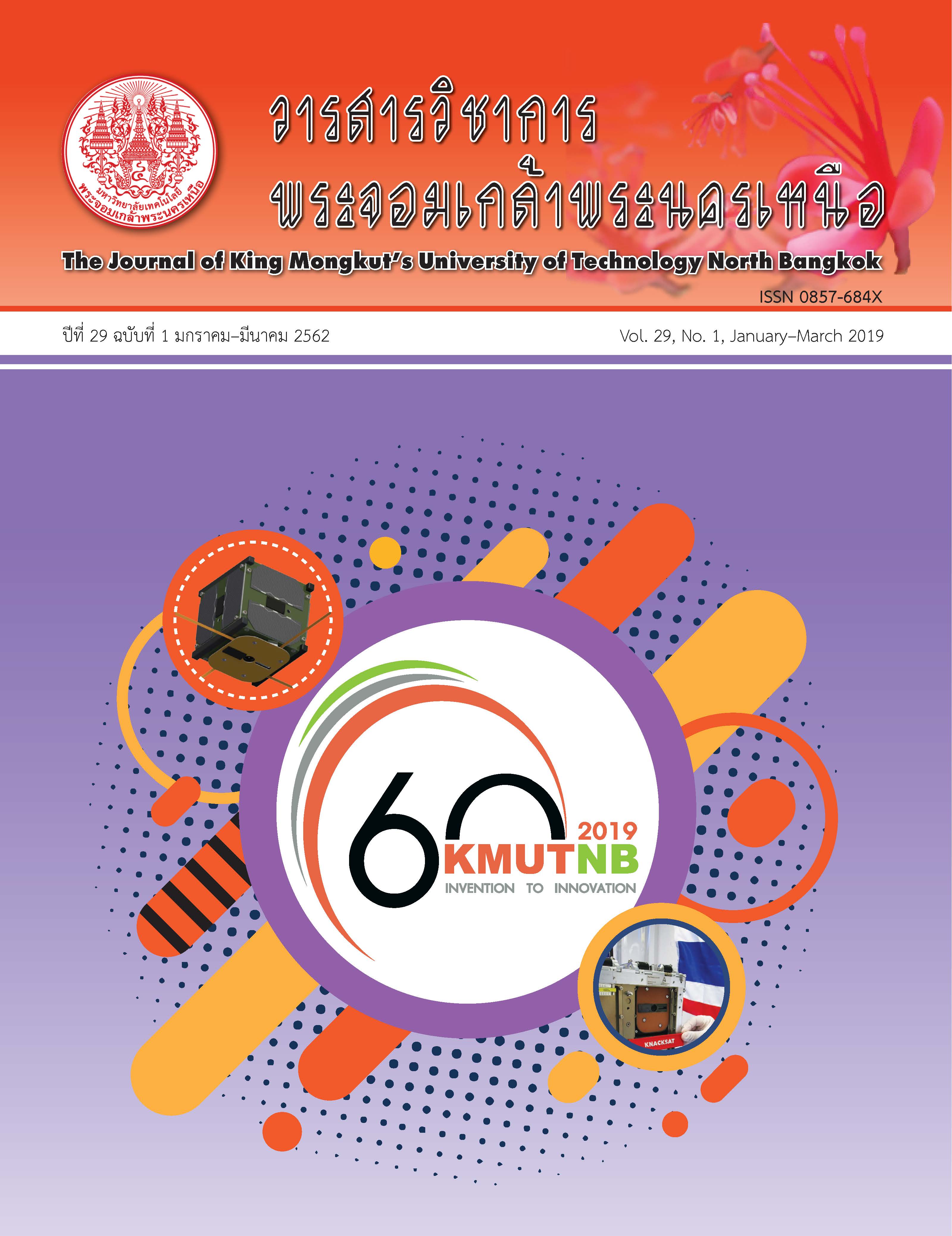การทดลองอบแห้งยางแผ่นด้วยเครื่องอบแห้งพลังงานแสงอาทิตย์แบบผนังด้านบนห้องอบแห้งเป็นแผ่นรับรังสีดวงอาทิตย์
Main Article Content
บทคัดย่อ
งานวิจัยนี้ทำการทดลองอบแห้งยางแผ่นด้วยเครื่องอบแห้งพลังงานแสงอาทิตย์แบบผนังด้านบนห้องอบแห้งเป็นแผ่นรับรังสีดวงอาทิตย์ ในการทดลองนี้มีการควบคุมสภาวะการอบแห้งเป็น 3 ช่วง สำหรับวันที่ 1 ความเร็วอากาศในห้องอบแห้ง 0.2 เมตร/วินาที เปิดช่องระบายอากาศ 550 ซม.2 ส่วนวันที่ 2–5 ความเร็วอากาศในห้องอบแห้ง 0.2 เมตร/วินาที เปิดช่องระบายอากาศ 275 ซม.2 และในช่วงสุดท้ายระหว่างวันที่ 6–8 ความเร็วอากาศในห้องอบแห้ง 0.1 เมตร/วินาที เปิดช่องระบายอากาศ 110 ซม.2 พบว่าพื้นที่ช่องระบายอากาศและความเร็วอากาศมีผลต่อการควบคุมอุณหภูมิของเครื่องอบแห้งพลังงานแสงอาทิตย์ ในช่วงแรกของการอบแห้ง (วันที่ 1) เครื่องอบแห้งมีอุณหภูมิเฉลี่ย 40°ซ ความชื้นสัมพัทธ์เฉลี่ย 38% หลังจากนั้น (วันที่ 2–5) มีอุณหภูมิเฉลี่ยเพิ่มขึ้นเป็น 48°ซ ความชื้นสัมพัทธ์เฉลี่ย 25% และในช่วงสุดท้าย (วันที่ 6–8) มีอุณหภูมิเฉลี่ยเพิ่มขึ้นเป็น 54°ซ ความชื้นสัมพัทธ์เฉลี่ย 18% ที่อุณหภูมิสิ่งแวดล้อมเฉลี่ย 31°ซ ความชื้นสัมพัทธ์เฉลี่ย 46% รังสีดวงอาทิตย์เฉลี่ย 708 วัตต์/เมตร2 และเปรียบเทียบแบบจำลองอบแห้งชั้นบางกับผลการทดลองพบว่าแบบจำลองของ Page ทำนายอัตราส่วนความชื้นของการอบแห้งด้วยเครื่องอบแห้งและการผึ่งยางแผ่นในที่ร่มได้แม่นยำกว่าแบบจำลองของ Newton และ Henderson and Pabis โดยมีช่วงค่า R2 0.9825–0.9841, Adjusted R2 0.9822–0.9837, SSE 0.04347–0.04918, RMSE 0.03074–0.0327 สำหรับการอบแห้งด้วยเครื่องอบแห้งและมีช่วงค่า R2 0.9672–0.9826, Adjusted R2 0.9665–0.9823, SSE 0.03055–0.06592, RMSE 0.02577–0.03786 สำหรับการอบแห้งด้วยการผึ่งในที่ร่ม
Article Details
บทความที่ลงตีพิมพ์เป็นข้อคิดเห็นของผู้เขียนเท่านั้น
ผู้เขียนจะต้องเป็นผู้รับผิดชอบต่อผลทางกฎหมายใดๆ ที่อาจเกิดขึ้นจากบทความนั้น
เอกสารอ้างอิง
[2] T. Ninchuewong, A. Ekphon, S. Tirawanichakul, and Y. Tirawanichakul, “Drying of air dried sheet rubber using hot air dryer and solar dryer for small entrepreneurs and small rubber cooperatives,” Burapha Science Journal, vol. 17, no. 2, pp. 50–59, 2012 (in Thai).
[3] W. Jeentada, P. Phetsongkram, and T. Chankrachang, “Drying of para rubber sheet using forced convection solar dryer,” Burapha Science Journal, vol. 21, no. 1, pp. 87–99, 2016 (in Thai).
[4] R. Dejchanchaiwong, A. Arkasuwan, A. Kumar, and P. Tekasakul, “Mathematical modeling and performance investigation of mixed-mode and indirect solar dryers for natural rubber sheet drying,” Energy for Sustainable Development, vol. 34, pp. 44–53, 2016.
[5] M. Yahya, A. Fudholi, H. Hafizh, and K. Sopian, “Comparison of solar dryer and solar-assisted heat pump dryer for cassava,” Solar Energy, vol. 136, pp. 606–613, 2016.
[6] M. A. Eltawil, M. M. Azam, and A. O. Alghannam, “Energy analysis of hybrid solar tunnel dryer with PV system and solar collector for drying mint (MenthaViridis),” Journal of Cleaner Production, vol. 181, pp. 352–364, 2018.
[7] D. K. Rabha and P. Muthukumar, “Performance studies on a forced convection solar dryer integrated with a paraffin wax–based latent heat storage system,” Solar Energy, vol. 149, pp. 214–226, 2017.
[8] W. Wang, M. Li, R. H. E. Hassanien, Y. Wang, and L. Yang, “Thermal performance of indirect forced convection solar dryer and kinetics analysis of mango,” Applied Thermal Engineering, vol. 134, pp. 310–321, 2018.
[9] E. Baniasadi, S. Ranjbar, and O. Boostanipour, “Experimental investigation of the performance of a mixed-mode solar dryer with thermal energy storage,” Renewable Energy, vol. 112, pp. 143–150, 2017.
[10] S. Surbkar and R. Assawarachan, “Mathematical drying models for porous materials,” Thai Society of Agricultural Engineering Journal, vol. 17, pp. 59–68, 2011 (in Thai).
[11] W. Jeentada, P. Kongboon, S. Boonyanuwat, and C. Sirirak, “Thin-layer drying models for para rubber sheet,” KKU Engineering Journal, vol. 41, pp. 99–108, 2014 (in Thai).
[12] E. O. M. Akoy, “Experimental characterization and modeling of thin-layer drying of mango slices,” International Food Research Journal, vol. 21, no. 5, pp. 1911–1917, 2014.
[13] G. Srivichai, “A study of performance of the induction heating dryer,” The Journal of KMUTNB., vol. 26, no. 3, pp. 375–383, 2016 (in Thai).
[14] C. Chen, “Evaluation of air oven moisture content determination methods for rough rice,” Biosystems Engineering, vol. 86, no. 4, pp. 447–457, 2003.
[15] I. Ceylan and A. E. Gurel, “Solar-assisted fluidized bed dryer integrated with a heat pump for mint leaves,” Applied Thermal Engineering, vol. 106, pp. 899–905, 2016.
[16] D. Jain and P. B. Pathare, “Study the drying kinetics of open sun drying of fish,” Journal of Food Engineering, vol. 78, no. 4, pp. 1315–1319, 2007.
[17] Q. L. Shi, C. H. Xue, Y. Zhao, Z. J. Li, and X. Y. Wang, “Drying characteristics of horse mackerel (Trachurus japonicus) dried in a heat pump dehumidifier,” Journal of Food Engineering, vol. 84, no. 1, pp. 12–20, 2008.
[18] M. Kalender, “Thin-layer infrared drying characteristics of construction gypsum plaster and selection of a suitable drying model,” Construction and Building Materials, vol. 155, pp. 947–955, 2017.
[19] J. Jiang, L. Dang, H. Tan, B. Pan, and H. Wei, “Thin layer drying kinetics of pre-gelatinized starch under microwave,” Journal of the Taiwan Institute of Chemical Engineers, vol. 72, pp. 10–18, 2017.
[20] K. B. Koua, W. F. Fassinou, P. Gbaha, and S. Toure, “Mathematical modelling of the thin layer solar drying of banana, mango and cassava,” Energy, vol. 34, no. 10, pp. 1594–1602, 2009.

